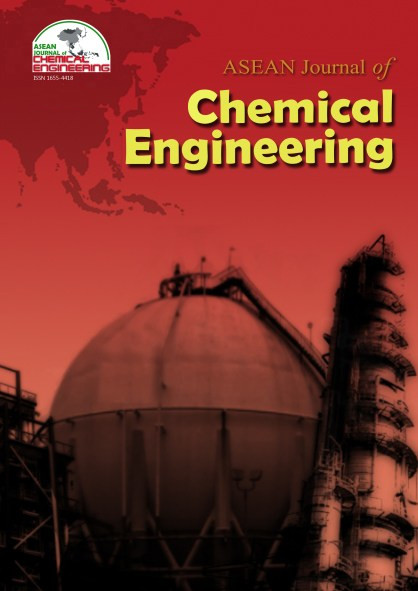Statistical Approaching for Superhydrophobic Coating Preparation using Silica Derived from Geothermal Solid Waste
Abstract
Material quality can be affected by humidity resulting in short durability. Many observations have been conducted to endure the durability of material, such as coating methods. However, recent methods are unaffordable. Therefore, this paper observes efficient and effective method to prepare superhydrophobic silica coatings derived from geothermal waste. The method was conducted by spraying. The objective of this paper is to observe optimum condition by using variables of silica concentration, TMCS (trimethylsilyl chloride) concentration, solvents and materials confirmed by contact angle of material based on statistical analysis. The study consisted of silica treatment for purification and preparation of superhydrophobic silica coatings. The study was carried out in factorial design of 81 experiments with one-time replication through Design Expert software (version 8.0.6). Based on previous research, the experiment was obtained optimum condition at 5.5 %w/v, 13 %v/v, isooctane, zinc coated for silica concentration, TMCS concentration, solvent and material, respectively, releasing contact angle by instrumentation of 180°. By ANOVA analysis, it was also complied the optimum condition of the superhydrophobic coating solution preparation achieved the same condition with experimental data releasing contact angle of 179.69°.
References
2. Eakins, W. J. (1968). “Silanol Groups on Silica and Their Reactions with Trimethyl Chlorosilane and Trimethysilanol”, I&EC Prod. Res. Dev., 7 (1), 39-43. (https://doi.org/ 10.1021/i360025a009).
3. Glass, S. V., and TenWolde, A. (2007). A. Review of In-Service Moisture and Temperature Cosditions in Wood-Frame Buildings, United States Department of Agriculture: Quilcene, WA, USA, 25-30. (https://doi.org/ 10.2737/FPL-GTR-174).
4. Hasanuzzaman, M., Rafferty, A., Sajjia, M., and Olabi, A.-G. (2015). Reference Module in Materials Science and Materials Engineering, Elsevier. (https://doi.org/10.1016/B978-0-12-803581-8.03998-9).
5. Hwang, S.-W., Kim, T.-Y., and Hyun, S.-H. (2008). “Optimization of instantaneous solvent exchange/surface modification process for ambient synthesis of monolithic silica aerogels”, J. Colloid Interfaces Sci., 322 (1), 224-230. (https://doi.org/10.1016/j.jcis.2008.02.060).
6. Kumudinie, C. (2001). Encyclopedia of Materials: Science and Technology (Second Edition), Elsevier. (https://doi.org/10.1016/B0-08-043152-6/01356-5).
7. Kousaalya, A.B, Garg, N., and Kumar, R. (2013). “Silica-based superhydro-phobic coating by a single-step process”, Surface Innovations, 1 (3), 173-180 (https://doi.org/10.1680/si.12.00014)
8. Latthe, S. S., Terashima, C., Nakata, K., Sakai, M., and Fujishima, A. (2014). “Development of sol–gel processed semi-transparent and self-cleaning superhydrophobic coatings”, J. Mater. Chem. A, 2 (15), 5548-5553. (https://doi.org/10.1039/C3TA15017H
9. Liu, J., Janjua, Z.A., Roe, M., Xu, F., Turnbull, B., Choi, K., Hou, X. (2016). “Super-Hydrophobic/Icephobic Coatings Based on Silica Nanoparticles Modified by Self-Assembled Monolayers”, Nanomaterials, 232 (6), 1-10. (https:// doi:10.3390/nano6120232)
10. Montgomery, D. C. (2001). Design and Analysis of Experiments, John Wiley & Sons, Inc., New York.
11. Purnomo, A., Dalanta, F., Oktaviani, A. D., and Silviana, S. (2018). “Superhydrophobic coatings and self-cleaning through the use of geothermal scaling silica in improvement of material resistance”, AIP Conf. Proc., 2026 (1), 020077. (https://doi.org/10.1063/1.5065037).
12. Rao, A. V., Latthe, S. S., Nadargi, D. Y., and Ganesan, V. (2009). “Preparation of MTMS based transparent superhydrophobic silica films by sol–gel method”, J. Colloid Interf., 332 (2), 484-490. (https://doi.org/10.1016/j.jcis.2009.01.012).
13. Silviana, S. Hasbi, R. M., Sagita, C. P., Nurhayati, O. D., Fauzan, A., Suhartana, Hatmoko, J. U. D. (2017). “Silika alam dari limbah padatan pengeboran geothermal di Dieng sebagai silika gel melalui proses ramah lingkungan“, Prosiding Seminar Nasional Teknologi Industri Hijau 2 2017, 341-346. (http://sntih.kemenperin.go.id/prosiding/?hal=prosiding)
14. Sun, T., Hao, H., Hao W.-T., Yi, S.-M., Li, X.-P., and Li, J.-R. (2014). “Preparation and antibacterial properties of titanium-doped ZnO from different zinc salts”, Nanoscale Res. Lett., 9 (98). (https://www.doi.org/10.1186/1556-276X-9-98).
15. Wang, N., and Xiong, D. (2014). “Influence of trimethylethoxysilane on the wetting behavior, humidity resistance and transparency of tetraethylorthosilicate based films”, Appl. Surf. Sci., 292 (1), 68-73. (https://doi.org/10.1016/j.apsusc.2013.11.070).
16. Xue, L., Li, J., Fu, J., and Han, Y. (2009). “Super-hydrophobicity of silica nanoparticles modified with vinyl groups”, Colloid Surf., 338 (3), 15-19. (https://doi.org/10.1016/j.colsurfa.2008.12.016).
17. Yildirim, A., Khudiyev, T., Daglar, B., Budunoglu, H., Okyay, A. K., and Bayindir, M. (2016). “Superhydrophobic and Omnidirectional Antireflective Surfaces from Nanostructured Ormosil Colloid”, ACS Appl. Mater. Interf., 5 (3), 853-860. (https://doi.org/10.1021/am3024417).
Copyright holder for articles is ASEAN Journal of Chemical Engineering. Articles published in ASEAN J. Chem. Eng. are distributed under a Creative Commons Attribution-NonCommercial 4.0 International (CC BY-NC 4.0) license.
Authors agree to transfer all copyright rights in and to the above work to the ASEAN Journal of Chemical Engineering Editorial Board so that the Editorial Board shall have the right to publish the work for non-profit use in any media or form. In return, authors retain: (1) all proprietary rights other than copyright; (2) re-use of all or part of the above paper in their other work; (3) right to reproduce or authorize others to reproduce the above paper for authors’ personal use or for company use if the source and the journal copyright notice is indicated, and if the reproduction is not made for the purpose of sale.



